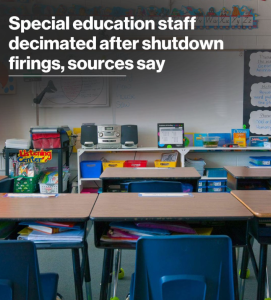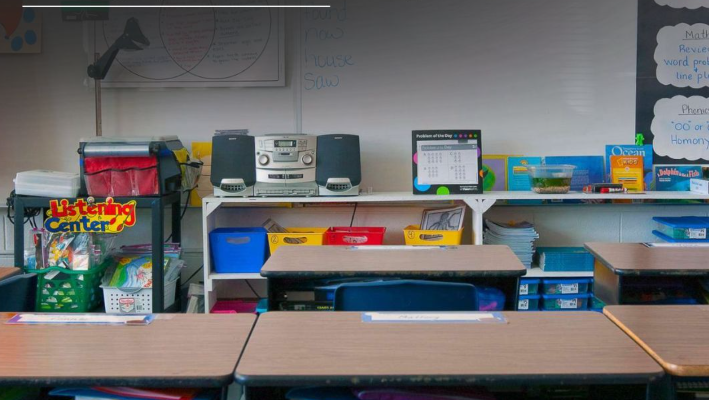
In the heart of Washington, D.C., tension rippled through federal education agencies and state-level school systems after reports emerged that special education departments across the country were being gutted in the wake of mass firings linked to a shutdown under the administration of Donald Trump. According to multiple anonymous sources inside the Department of Education and state education offices, hundreds of special education specialists, support coordinators, and program administrators were abruptly dismissed when funding was frozen during the extended federal government shutdown. While the full extent of the damage is still being assessed, educators, parents, and disability rights advocates have described the situation as nothing short of devastating.
The shutdown itself had already put immense pressure on public services nationwide. Agencies responsible for education funding had been operating on emergency reserves, struggling to maintain critical programs for students with disabilities. Special education services, governed in large part by the Individuals with Disabilities Education Act (IDEA), rely heavily on federal funding to ensure that students receive legally required accommodations and support. When the shutdown intensified, many of those funds were frozen or delayed, creating immediate uncertainty for programs that depend on them.
According to internal memos leaked to several reporters, the Trump administration ordered significant personnel reductions in non-defense discretionary departments, including education, as part of a broader effort to redirect resources toward security and border initiatives. This resulted in widespread layoffs that disproportionately affected special education staff at the federal level. States and local school districts that depend on federal grants were also forced to respond by cutting contracts, furloughing specialists, or reducing hours for aides who work directly with students.
One senior official described the scene as “chaotic and cruel.” Offices that once handled oversight and compliance for special education programs were left empty almost overnight. These positions are not simply administrative; they are essential for enforcing federal protections for students with disabilities. Without these staff members, school districts are left with minimal guidance, and families are finding it harder to ensure their children receive services they are legally entitled to.
The timing of the firings has worsened the situation. Many schools are in the middle of their fall term, when Individualized Education Program (IEP) meetings are scheduled and support plans are updated. With staff removed from their posts, critical meetings have been delayed or canceled. Teachers report being overwhelmed, forced to cover responsibilities that typically require specialized training and legal expertise. Parents are growing increasingly frustrated as services that were once guaranteed—such as speech therapy, occupational therapy, and classroom aides—are being delayed or discontinued.
Advocacy groups have sounded the alarm. Several disability rights organizations have already filed emergency complaints and lawsuits, arguing that the federal government is violating IDEA by failing to maintain adequate oversight and funding. One advocacy leader said, “This isn’t just a budget cut. This is an attack on a vulnerable population of students who rely on these programs to learn, communicate, and participate fully in school.” Legal experts agree that this may be one of the most significant challenges to special education law in decades.
The Trump administration has not issued a full public statement addressing the firings, but anonymous officials within the White House have characterized them as “necessary belt-tightening” during a fiscal crisis caused by what they claim is congressional inaction. According to these officials, programs deemed “non-essential” were subject to staffing cuts during the shutdown. Special education, they argued, remains a state and local responsibility, despite decades of federal involvement. This framing has enraged many education professionals, who point out that federal law explicitly mandates support for students with disabilities.
The consequences of these cuts are not abstract. Across the country, schools are already feeling the immediate effects. In rural areas, where special education programs often operate with minimal staff, even a few firings can dismantle an entire network of support. One district reported losing its only federal liaison, leaving teachers without anyone to coordinate specialized services or ensure compliance with legal requirements. In urban centers, understaffed programs have led to ballooning caseloads for remaining educators, pushing some to the brink of burnout.
Parents are facing some of the most painful impacts. Many families depend on federally supported programs not only for education but also for daily care and therapy that their children cannot access elsewhere. Losing access to speech or physical therapy at school can have long-term developmental consequences. Parents have described sleepless nights, emergency meetings with administrators, and growing fears that their children will fall behind irreparably.
Teachers, too, are struggling. Special education instructors already operate under immense pressure to meet individualized goals, document progress, and maintain legal compliance. With fewer specialists and aides to support them, many say they are being forced to make impossible choices: prioritizing one student’s needs over another’s, cutting back on individualized time, or neglecting legally mandated paperwork just to keep classrooms running. Several have warned that this situation is not sustainable.
The shutdown firings have also raised questions about the future of IDEA itself. The law has long been considered a bipartisan commitment to students with disabilities, but some experts fear this moment could mark a turning point. If federal involvement in special education is scaled back or neglected, states with fewer resources may simply not be able to uphold the same level of support. This could create a deep divide in educational equity between wealthy and poor districts.
Civil rights groups have begun organizing nationwide campaigns to pressure lawmakers to restore funding and rehire critical staff. Protests are being planned in several cities, with parents, teachers, and disability advocates expected to rally at state capitols and outside the Department of Education in Washington. Legal teams are preparing injunctions to compel the federal government to uphold its responsibilities under IDEA.
This unfolding crisis is also testing how quickly the education system can adapt under political strain. Some districts are trying to temporarily contract private specialists, but the costs are steep and the availability is limited. Others are relying on general education teachers to fill roles they are not trained for. These stopgap measures are no substitute for a well-funded, federally supported system of special education.
Observers note that the human cost of the firings may continue long after the shutdown ends. Even if funding is eventually restored, the loss of experienced personnel will take years to recover from. Special education requires training, dedication, and legal expertise. Rebuilding these teams cannot happen overnight. Meanwhile, students—especially those with complex needs—are the ones who will bear the brunt of this disruption.
The situation underscores a larger debate about the role of the federal government in public education. For decades, federal involvement has served as a safeguard to ensure that vulnerable populations are not left behind. By pulling back so abruptly, the government risks undermining hard-won protections that families have depended on for generations.
For parents, teachers, and students, this is not a political abstraction. It is a daily battle to secure services, keep classrooms functioning, and fight for the rights of children with disabilities. Whether through courtrooms, Congress, or community action, the coming months will determine whether these essential supports can be restored—or whether one of the most vulnerable groups in the education system will be left to fend for itself

